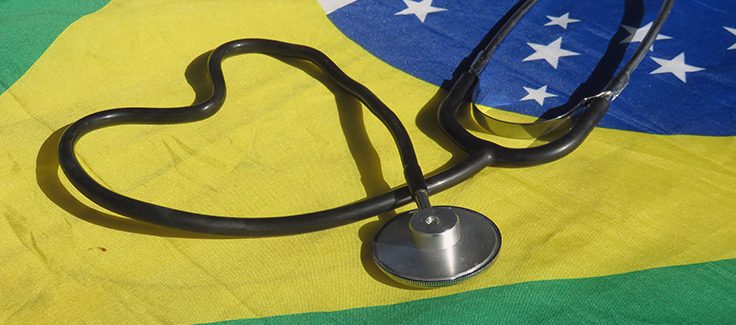The World Health Organization (WHO) estimates an average of 2 hospital beds per 1,000 inhabitants in Latin America and the Caribbean. In Brazil, whose population is estimated at 214 million, the national average is around 1.99 beds per 1,000 inhabitants, down from 2010, when the ratio was 2.23 (data from the National Health Confederation).
It is important to highlight an even more striking statistic: overall, the Brazilian hospital market has shrunk, with the number of hospitals falling from 7,488 in 2022 to 6,518 in 2024 and the number of hospital beds dropping from 461,878 to 380,329 during the same period. In 13 years, Brazil has lost 25,000 hospital beds in the Unified Health System (SUS) alone, according to a survey by the Federal Council of Medicine.
This scenario can be partly explained by the reduction in severe cases of COVID-19, although the country faced a dengue epidemic in 2024, with a high demand for hospitalizations.
Furthermore, considering the country’s extensive and diverse geography, distribution remains uneven. Most hospitals, particularly private ones, are located in the Southeast, especially in São Paulo and Minas Gerais, according to a survey by the National Health Confederation. Curiously, private hospitals predominate in highly populated municipalities (with more than 500,000 inhabitants) and outside the capitals. They are general hospitals with up to 50 beds, most of which are linked to the SUS.
On the other hand, the Brazilian hospital market is increasingly innovative, with segmented services, resources, and high-tech devices in both the public and private systems, guaranteeing more efficient, targeted care and higher positive outcome rates.
Hospital infrastructure in Brazil in 2024*
There are 6,518 hospitals in Brazil in 2024,
of which 38% are public and 62% are private.
In total, the country has 380,329 hospital beds and 29,309 operating rooms.
*Source: MedTech Outlook: Latin America 2024
Expansion in Brazil
Below, we list five public and private hospitals that have recently opened or expanded in Brazil.
Placi Network
Brasília, Federal District
In March 2014, Brasília launched its first transition hospital, providing after-surgery care and prolonged intensive hospitalization. The Placi Hospital in the federal capital is the first in the network to operate outside the state of Rio de Janeiro, where it has been operating since 2013. This unit has 88 beds and spaces for the care and rehabilitation of patients under the care of professionals 24 hours a day. There are 225 health professionals in the interdisciplinary team, including doctors, nurses, speech therapists, psychologists, and other specialties. The unit occupies about half of the Neo Life Integrated Health Center, close to Hospital Brasília.
Municipal Hospital of Magé
Magé, Rio de Janeiro
Launched in February 2024, the Municipal Hospital of Magé has expanded the range of medical services in public health, providing 62 beds – ten of which are in the Intensive Care Unit (ICU), including one for isolation. The unit also has seven beds in the high acuity unit (red room), two specifically for trauma, and eight in the immediate acuity unit (yellow room). The hospital has also invested in state-of-the-art diagnostics, including CT, X-ray, endoscopy, and colonoscopy equipment. Furthermore, the infrastructure offers a surgical center with two operating rooms and an anesthetic recovery room with three beds, as well as a 24-hour emergency service for adults and children.
New 60+ emergency room for the São Camilo Network
São Paulo, São Paulo
In May 2024, the São Camilo Hospitals Network opened a 60+ emergency room at its Vila Pompeia unit, exclusively for emergency care for people aged 60 or over. The facility can be accessed by all patients in this age group who have health insurance that covers consultations at the hospital, without the need for differentiated coverage. Designed to meet the increased demand from elderly patients, the ward offers care with staff trained to welcome the elderly and to speed up the hospitalization process, accompanied by geriatricians. To ensure greater comfort and safety for this age group, the unit has clear floors with no jagged edges, making it easier to move around, and it adopts a single flow system in which all stages of care are carried out in the same place, with no need for transfers.

DISCOVER NEW MARKETS
Get the data points you need to understand the Brazilian and Latin American hospital market
State Orthopedic Hospital
Salvador, Bahia
In March 2024, the largest state hospital for orthopedics and traumatology in Brazil was launched in Bahia. Under the management of the Brazilian Israeli Beneficent Society Albert Einstein, the institution received BRL 224 million in investments and boasts 212 beds, 30 of which are in intensive care units (ICU). The hospital provides 100% regulated outpatient and inpatient services (referenced by the State Regulation Center in urgent and emergencies and by the Single List System in elective cases), with an anticipated 290,000+ consultations a year, including 15,000 orthopedic surgeries – three times the current capacity of the state of Bahia. There are 13 operating rooms and MRI, CT, ultrasound, and X-ray scans, as well as a heated pool for aquatic physical therapy. In addition, the unit houses a musculoskeletal tissue transplant center for the region to support the performance of grafts.
Águas Lindas de Goiás State Hospital
Águas Lindas de Goiás, Goiás
After almost two decades under construction, the Águas Lindas de Goiás State Hospital (Heal) was opened in June 2024. This 164-bed facility is expected to benefit around 1.2 million people in over 30 municipalities in the region and receives referrals from the State Regulatory Complex for urgent and emergency cases. The hospital also houses a maternity ward, Intensive Care Unit (ICU), exams, and medium and high complexity services, such as CT, MRI, X-ray, ultrasound, blood and milk banks, and surgical procedures.
Next Steps
Contact GHI to discover more about the top hospitals in Latin America. Our annual HospiRank report offers in-depth information on the best-equipped hospitals in the region. Additionally, our HospiScope and ShareScope databases provide insights on medical equipment and company market shares for different types of medical equipment across various Latin American countries.



